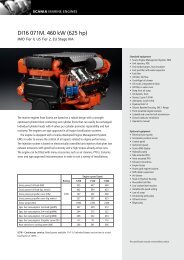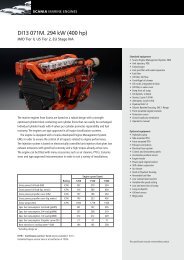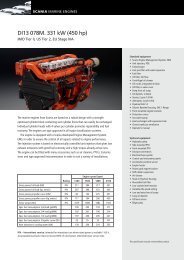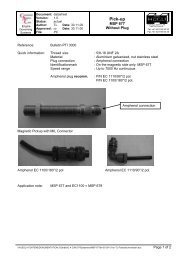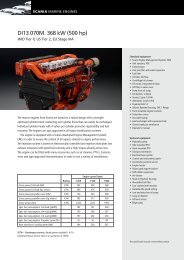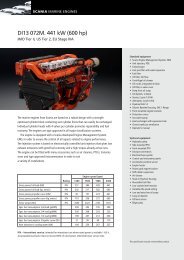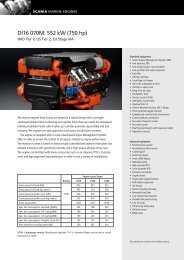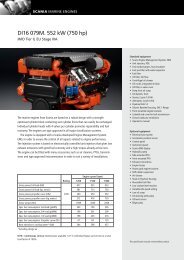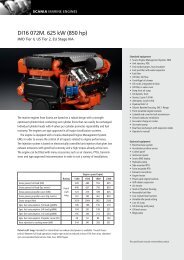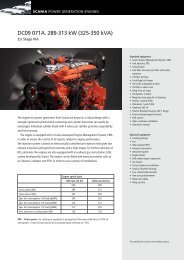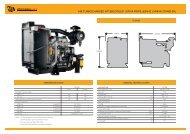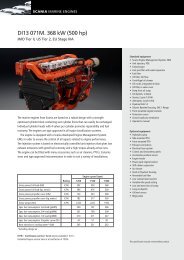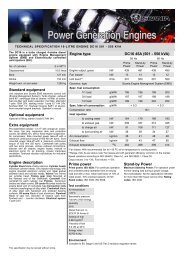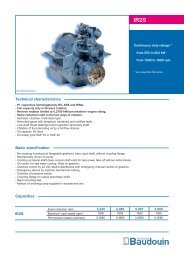ECC 326 - Huegli Tech
ECC 326 - Huegli Tech
ECC 326 - Huegli Tech
You also want an ePaper? Increase the reach of your titles
YUMPU automatically turns print PDFs into web optimized ePapers that Google loves.
DESCRIPTION<br />
Product Information<br />
The generator’s frequency, when used as an engine speed signal, can be either 50 or 60 Hz nominally. The<br />
minimum and maximum amplitude levels required to operate the <strong>ECC</strong><strong>326</strong> are 1V AC to 260V AC. The<br />
generator’s residual voltage must reach 1 V AC so the loss of speed signal will be defeated and allow the<br />
actuator to open the fuel valve to start the engine. Other than the Min and Max AC input values, the control<br />
is not very sensitive to the wave shape or the voltage levels from the generator.<br />
When the speed signal is received by the controller, the signal is conditioned to operate the GAC proprietary<br />
speed sensor circuit. If the speed signal disappears for longer than approximately 0.2 seconds, the actuator<br />
output will be shut off (loss of speed signal protection). When cranking the engine, the control unit will<br />
sense a very low frequency and operate the actuator to start the engine.<br />
The internal summing circuit receives the speed signal and combines it with the speed setting reference<br />
adjustment along with the remote speed trim setting. The output of the summing circuit is the input to the<br />
dynamics control circuits of which the gain and stability adjustments are a part. These control functions<br />
provide isochronous and stable performance.<br />
During engine cranking, the actuator should be fully energized and should move to the maximum fuel<br />
position. The actuator will remain in that state during engine cranking and acceleration up to the operating<br />
speed. With the engine at a steady load, the actuator will be energized with sufficient current to maintain<br />
the governed speed set point.<br />
The output circuit to the actuator provides a controlled switching current loop to the proportional actuator at<br />
a frequency of about 200 Hz. This switching frequency is well beyond the natural frequency response of the<br />
actuator, thus there is no visible motion of the actuator due to this switching circuit. Switching of the output<br />
transistor reduces internal power dissipation and provides for efficient power control up to 10 Amps of<br />
continuous current at 25°C. A proportional actuator will respond to the average current to position the<br />
engine fuel control lever.<br />
The <strong>ECC</strong><strong>326</strong> is compatible with all proportional GAC actuators except the ACB2000 which has too a high<br />
current requirement (15A).<br />
WIRING<br />
Basic electrical connections are shown in the Wiring Diagram, Fig. 1. Battery and actuator connections<br />
should be #16AWG (1.3mm2) or larger. Long cables require an increased wire size to minimize voltage<br />
drops. The battery positive (+) input, Terminal F, should be fused for 15A.<br />
Connection to the generator: The two input Terminals, D and E, should be connected to the generator’s AC<br />
windings. These connections can be either line to line or line to neutral. Terminal E should be connected to<br />
the neutral if this connection is chosen. See the wiring diagram for various connections to the generator.<br />
2080 V1.0 17.10.2008 Page 2 of 6



